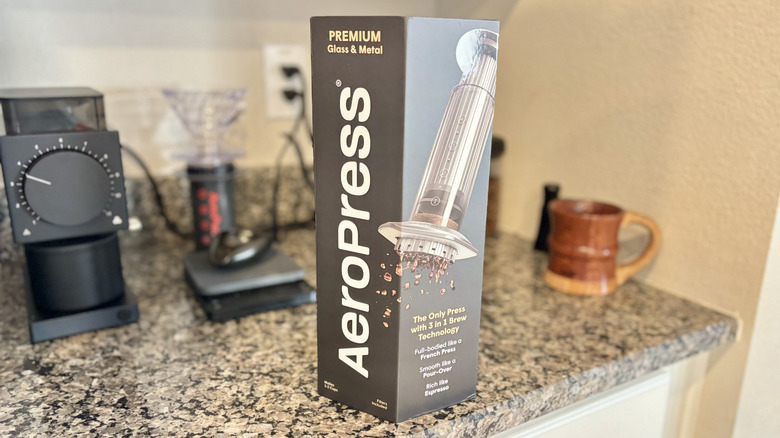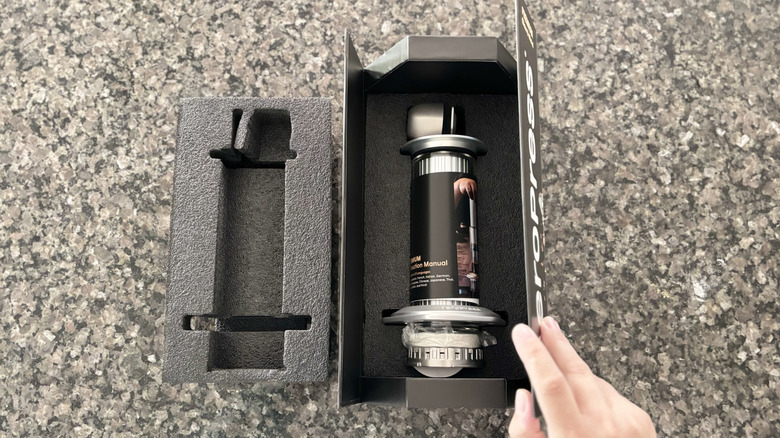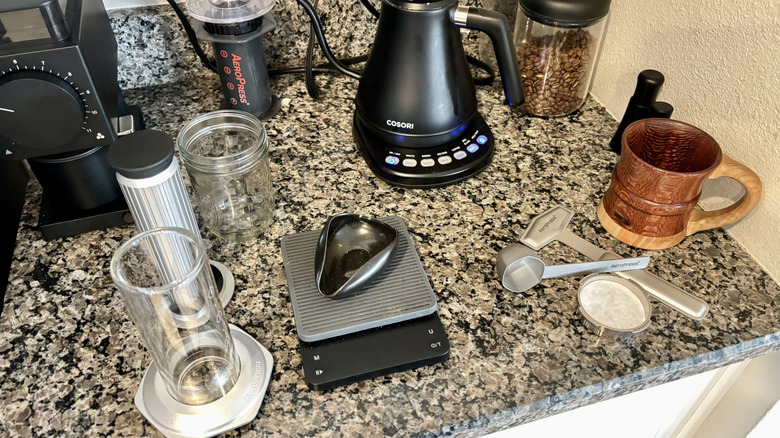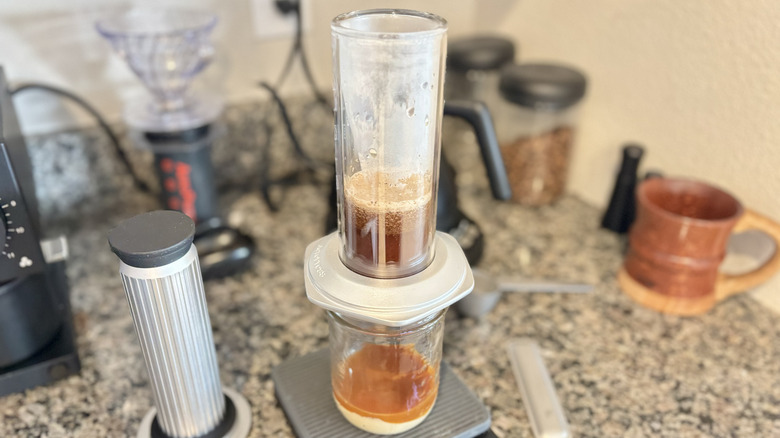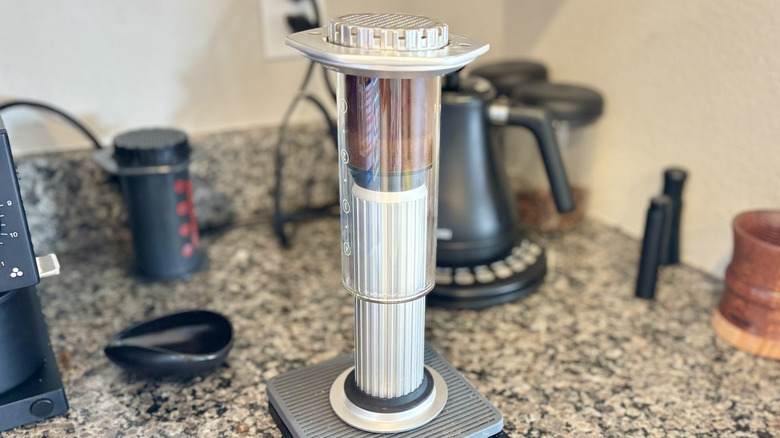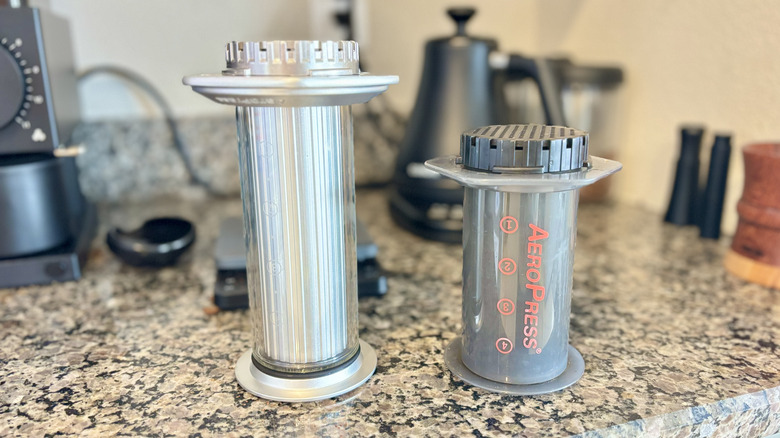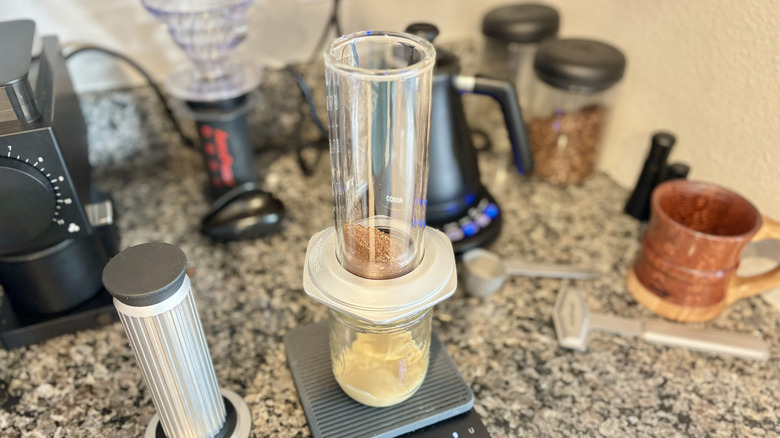Review: How The AeroPress Premium Measures Up To The Original
We may receive a commission on purchases made from links.
My husband and I have been on something of a mission over the last year. We are driven to upgrade our coffee bar setup and love a good coffee gadget (see some of the best gadgets available for caffeine fans). We've tried several espresso machines, only to return many of them. We even tried the new Ninja Lux Café, only to receive two faulty machines. With each failed machine, we were left with the same feeling: Our AeroPress can do it better. It's quite a feat, but this plastic machine that costs less than $40 makes some of my favorite coffee I've ever had.
We have been using our AeroPress several times a day for almost two years. While my husband tends to prefer his Hario V60 coffee maker, (differences between the two gadgets are explained here), my heart belongs to AeroPress, which works best with fine grounds. There's so much flexibility. The ease of making espresso-style drinks with minimal equipment is satisfying. The process is pretty simple: You pour coffee grounds into an immersion chamber, add hot water, allow it to steep for a designated length of time, and then press. In some ways, it feels quite like a French press but in a smaller package. Having been a French press user throughout my Starbucks barista years, the AeroPress feels like something of a comfortable callback.
So when the company reached out about its new AeroPress Premium, I was eager to try it. I remained skeptical on whether it would actually improve my morning coffee. Still, I plunged forward for a head-to-head comparison and overall review of this luxury version.
Some recommendations are based on firsthand impressions of promotional materials and products provided by the manufacturer.
AeroPress Premium specs and features
When the new AeroPress Premium arrived, the first thing I noticed was that almost every component in the new model had been upgraded from the AeroPress Original. The plunger piece is made of anodized aluminum instead of plastic, and the cylindrical walls that hold the coffee and water are made from what the company calls double walled borosilicate glass rather than the plastic that comes in the original. The stopper that holds the AeroPress over your cup is now aluminum, and the filter cap is stainless steel instead of plastic like the original.
The box includes a stirrer and scoop that are both made of stainless steel. The new version also comes with paper micro-filters, the same ones used in the original model. All of the upgrades make for a fairly heavy handheld coffee machine. Weighing nearly 2 pounds, the premium model has a lot more heft than the 6.4 ounces in the original.
Price and availability of the AeroPress Premium
The AeroPress Premium machine is priced at $149.99, which is more than three times the cost of the original AeroPress, which was first introduced at a coffee event in 2005 in Seattle. You'll find the latest model available for purchase on the company's website as well as at the Williams Sonoma site.
As of the writing of this article, the coffee maker is listed as shipping out from Williams Sonoma with an estimated arrival date of mid-November, but the AeroPress website still has it listed as available only for pre-order. The ones from AeroPress are shipped with an estimated arrival being somewhere close to the December holiday season. That means you won't have it in your hands until snow starts to fall in some places in the country. If you're looking to dive right in sooner, Williams Sonoma is probably your best bet.
Trying the AeroPress Premium in the traditional style
To prepare my first coffee using the AeroPress Premium, I measured out and ground 18 grams of coffee. I'm currently sipping on Honduras Ronnie Gabrie Parainema from one of my favorite barista-approved brands: Onyx Coffee Lab. It has tasting notes of cranberry, dark chocolate, plum, and red wine. It's a rich coffee that I'm really enjoying. I've been using Fellow's Ode Brew Grinder on setting 3.2, and it's been perfect for the AeroPress. After grinding, I set my paper filter in the sturdy stainless steel filter cap, which I screwed in before pouring my coffee grounds into the chamber. On top of the coffee goes 125 grams of water at 205 degrees Fahrenheit. There's a steep time of one minute before pressing on top of some sweetened condensed milk, which you can make from scratch at home if you're out.
Using the new model, I was struck by just how heavy everything is compared to the AeroPress Original. Every single item has a more substantial feel to it. I found myself working a little slower than normal. Since the coffee chamber is made of glass, I was concerned I was going to break something by moving too quickly. Generally, morning coffees around my home are made through half slits, so this might become more of an afternoon coffee machine, when the risk of busting something doesn't seem quite so imminent. The coffee it produced was exactly what I would have expected from one of the top choices in a ranking of the best coffee makers, so there were no real surprises, especially given my familiarity with the Original.
Trying the AeroPress Premium in the inverted style
When I make my coffee in the morning, I use an inverted method with the AeroPress. That is, instead of the coffee dripping into my mug right away, it steeps together with the water in the chamber, and then I flip it over and press. It makes for a rich coffee flavor that I'm obsessed with. I wasn't expecting the inverted method to be much different with the AeroPress Premium, but it sure was. I should note that this isn't a method AeroPress endorses. The AeroPress website says officials "strongly discourage using the inverted method because it is less stable and therefore prone to tipping over and exposing the user to hot liquid." Spend a bit of time reading about AeroPress online, however, and you'll see it everywhere. But I digress.
The inverted style has the plunger top resting on the counter and the pouring of coffee and water in much the same way. The big difference is that with the inverted method, I gently press down on the stainless steel filter cap to get rid of the air and allow the water and coffee to steep. It's an inverted plunging, but pushing the AeroPress Premium is a little difficult because there's a certain amount of resistance you need to feel to know when to stop pushing. That's very challenging when the gadget is as heavy as it is. Because of the weight, it's tough to tell when exactly you meet the coffee grounds as you press the top down, and it also feels unwieldy standing on the scale as I fill up the chamber with water and coffee.
AeroPress Premium vs AeroPress Original
Looking at the AeroPress Premium and AeroPress Original side by side, it may seem that the Premium can make more coffee because it looks bigger, but it actually has the same capacity – 10 ounces – as an AeroPress Original. They also use the same filters, which are paper, unless you upgrade to a reusable stainless steel one, which is sold separately. In terms of build, these two coffee makers are pretty different. The Original is largely plastic while the Premium is mostly a mixture of metals and glasses.
Before busting into the Premium, I was dying to know whether the quality of coffee would stack up to the Original, and as you might expect, it does. However, it doesn't surpass it. In making two drinks, pitting the makers against one another, I used the inverted method since that's the method I use the most often. The same beans, same time, same measurements, same sweetened condensed milk, and same ice nuggets yielded nearly identical — and tasty — results.
Final thoughts after using the AeroPress Premium
I find it interesting that the AeroPress Original and Premium use the same paper filter. This is one of the few parts that isn't upgraded with the newer model. Though you can purchase a reusable stainless steel filter, it isn't included with the Premium. It would have been a nice addition, given the newer model's price tag and the fact that every single part of the original brewer had been upgraded. It isn't a huge loss, but it would've made more sense.
In terms of whether the AeroPress Premium is worth the splurge, you'll want to consider your household. If you, like us, view coffee as more of a tool of survival in the morning and then transition it into more of a fun drink later in the day, it might be worth the higher price because it just feels like such a luxury item. Note, though, it doesn't necessarily produce better coffee. So if you're hoping for something that vastly upgrades what you already have, the Premium probably isn't going to be it. If you have a few extra coins and are looking to just jazz up a small part of your life, it might be worth the splurge.
While I am thrilled to have a second AeroPress in the house, I'm not sure it's worth the extra cost. Honestly, the AeroPress Original is just so good. It's really hard to beat a product that already far surpasses more expensive ones.
